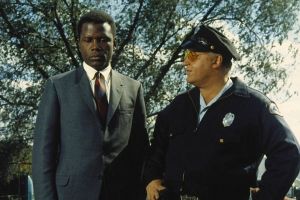In The Heat Of The Night (1967)
In The Heat of The Night is a American mystery-drama film who released on August 2, 1967 in United States. Directed by Norman Jewison and Produced by Walter Mirisch. This movie based on John Ball's 1965 novel of the same name (In The Heat of The Night) and tells about Virgil Tibbs played by Sidney Poitier as a black detective who suffers racial slurs and humiliation at the hands of a white police chief Bill Gillespie played by Rod Steiger while he tries to solve a murder in a small town in Mississippi. It also starring
- Warren Oates as Sam Wood
- Lee Grant as Mrs. Colbert
- Larry Gates as Endicott
- James Patterson as Lloyd Purdy
- William Schallert as Mayor Schubert
- Beah Richards as Mama Caleba
Contents
Plot
Philip Colbert, a wealthy man in Chicago, was murdered when he planned to build a factory in a small village in Sparta, Mississippi. Police Chief Bill Gillespie is under pressure and must find Colbert's murderer immediately.
Afro-American Virgil Tibbs passed by the roadside and was picked up by a racist policeman at the train station. He found that Tibbs had a lot of cash in his pocket. Tibbs was taken to the police station. Gillespie was very prejudiced against blacks and concluded that he was the culprit, but was embarrassed to learn that Tibbs was a Philadelphia homicide detective who visited his mother. After receiving the treatment of paranoia and racism, Tibbs only hoped to leave Sparta as soon as possible, but his captain from Philadelphia advised him to stay and assist in the investigation.
Tibbs initially suspected Eric Endicott, the wealthy plantation owner, who opposed the new factory. When he tried to ask Endicott about Colbert, Endicott slapped him. Tibbs slapped him, which caused Endicott to send a group of countryman gangsters after Tibbs. Gillespie rescued Tibbs from the battle and ordered him to leave the town for safety reasons. Tibbs refused to leave until he resolved the case. Tibbs asks Sam Wood, the policeman who found the body, to trace back the actions of the night of the murder. He patrolled with Gillespie and Sam, and at a dinner, the counter attendant Ralph Henshaw refused to serve Tibbs because he was black. Purdy insulted the black male Tibbs there and asked his sister to interrogate her about her sexual experience with Sam. He gathered a mob of lynchings to avenge Tibbs.
Tibbs cleared Sam by identifying the original scene of the crime and determining that Sam might not be able to drive two vehicles at the same time to dispose of the body and the victim's vehicle during the patrol. Tibbs intuitively found an abortion in a nearby backyard and found that someone had performed an abortion for Delores Purdy. When Delores returned, Tibbs chased her outside, where he met the murderer: Ralph Henshaw, the restaurant counter. After finishing Tibb's work, he finally boarded the bay and the Mobile and Ohio trains left the city, which was sent away by a more respected Gillespie.
Controversy
In one scene, Tibbs was interrogated by the countryman police chief Bill Gillespie (Rod Steiger) of Mississippi (the most racist in the United States). Tibbs spoke with hatred and suspicion. In a world that will not succumb to him, he is a black man. He realized that the words seemed meaningless.[1] It also uses racism as a way of life, describing people trapped by benign isolation and arrogant attitudes. The city center is an insidious hatred that intensifies a quirky, respected concept of southern culture.[2]
The film also shows the ways in which a police officer who cannot accept detectives can do better than him, simply because he is black.[3]
Pros
Racims can be solved as long as the people start to respect to each other "In the Heat of The Night takes some shortcuts in its vision of race and prejudice, but it also works as a strong exploration of race to this day. It’s what we might call a reconciliation film — a story in which a white character learns to be less racist because of his or her interactions with a black character"[4]
Ingeniously put the mystery and detective works that are usually the center of the story into the film's exploration of American racism, while at the same time depicting the original scene of the hateful South in the 1960s.[5]
Reference
- ↑ https://www.sensesofcinema.com/2017/1967/in-the-heat-of-the-night/#fnref-29183-1
- ↑ https://lwlies.com/reviews/in-the-heat-of-the-night-1967/
- ↑ https://www.scmp.com/magazines/post-magazine/arts-music/article/2149701/revisiting-heat-night-film-confronted-racism
- ↑ https://religionnews.com/2020/06/10/what-movies-by-and-about-african-americans-can-teach-us-in-this-hard-present/
- ↑ https://sbiff.org/in-the-heat-of-the-night/


